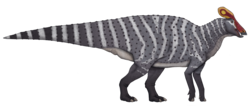You can help expand this article with text translated from the corresponding article in Spanish. (January 2020)Click [show] for important translation instructions.
|
| Cerro del Pueblo Formation | |
|---|---|
| Stratigraphic range: Campanian ~ | |
 | |
| Type | Geological formation |
| Unit of | Difunta Group |
| Underlies | Cerro Huerta Formation |
| Overlies | Parras Shale |
| Thickness | 160 m (520 ft) |
| Lithology | |
| Primary | Mudstone, sandstone |
| Other | Siltstone, conglomerate, limestone |
| Location | |
| Coordinates | 26°06′N101°06′W / 26.1°N 101.1°W |
| Approximate paleocoordinates | 32°12′N75°30′W / 32.2°N 75.5°W |
| Region | Coahuila |
| Country | Mexico |
| Extent | Parras Basin |


The Cerro del Pueblo Formation is a geological formation in Saltillo, capital city of the state of Coahuila, Mexico, whose strata date back to the latest Campanian of the Late Cretaceous, just before the Campanian-Maastrichtian boundary. Dinosaur remains are among the fossils that have been recovered from the formation. [1] The formation is believed to correlate with the Baculites reesidesi and Baculites jenseni ammonite zones, which dates it to 73.63-72.74 Ma. [2]
Contents
- Paleobiota
- Dinosaurs
- Pterosaurs
- Turtles
- Fish
- Fossil eggs
- Mammals
- See also
- References
- Bibliography
- Further reading

The Cerro del Pueblo Formation includes marine, brackish, and non-marine environments, and was laid down in a coastal lowland environment, with Coahuila being on the edge of the Western Interior Seaway at the time. Fossils are abundant in the Cerro del Pueblo Formation, and include dinosaurs and other vertebrates, plants and seeds, and invertebrates including oysters, snails, and other molluscs. The formation is underlain by the Parras Shale and is overlain by the Cerro Huerta Formation.









